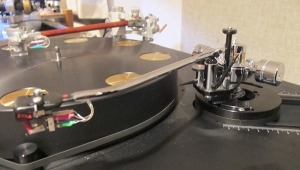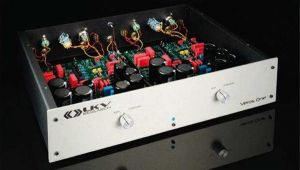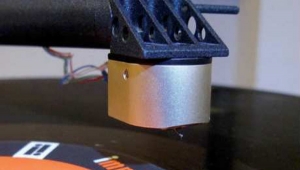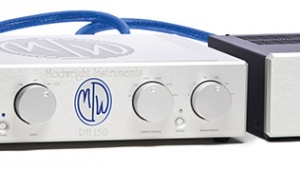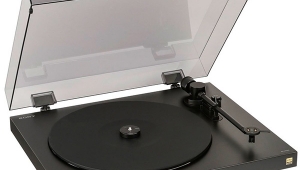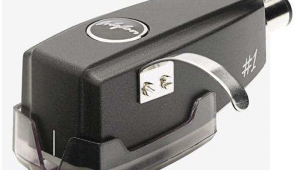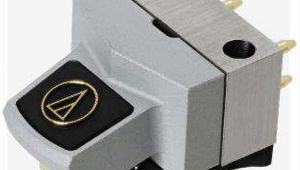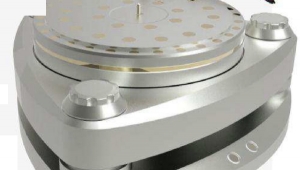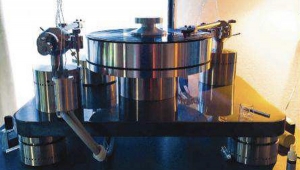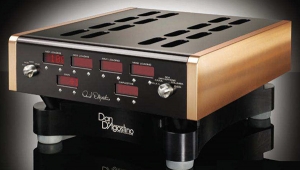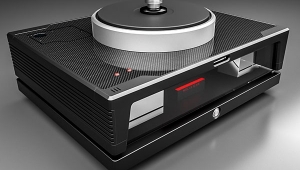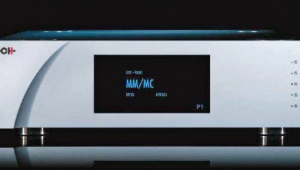| Columns Retired Columns & Blogs |
Analog Corner #248: Mørch DP-8, Reed 3P tonearms, TechDAS Air Force One turntable Page 2
The 3P's overall tonal balance was neutral to a bit sweet, particularly in the midrange, without the sound growing a midband bubble or transients losing their natural edge. Was that sweet midrange the result of the Brazilwood? Maybe: I didn't measure. Bass was nimble, clean, and well extended, though it didn't quite match the Kuzma 4Point's iron-fisted authority in the lows. (I'm not comparing anything to the Swedish Analog Technologies arm.) On the other hand, the 3P's midrange will surely appeal to those who, unlike me, find the 4Point somewhat austere in that region.
Footnote 6: Mørch, Skovvej 16, 2820 Gentofte, Denmark. Tel: (45) 396-34512. Web: www.moerch.dk. US distributor: SORAsound. Tel: (773)706-9705. Web: www.sorasound.com
Advocates of unipivot tonearms will say that an arm that has, essentially, three "unipivots" won't perform as well as one with a single unipivot because, instead of concentrating the mass at a single point, it's dividing it among three or, as in the 4Point, four. Whatever, the Reed 3P's sound was tonally very well balanced from top to bottom, with no obvious colorations, and a midrange that was, overall, pleasingly warm without being too warm. Unless you really like sweet and warm, use the 3P with a cartridge whose sound is close to neutral.
The Reed 3P was a stable tracker; its behavior in the groove was exemplary with both the Etna and the A95. While the 3P did well with all types of music, I especially recommend it for LPs of acoustic music and women's voices.
The Reed 3P tonearm is impressively designed, engineered, and manufactured. I was impressed by the many options offered, and especially by the complete documentation posted on the company's website. Other than the confusion about "mounting distance," the folks at Reed seem to be doing everything correctly—and, on all counts, very well.

The Mørch DP-8 on a Feickert Firebird turntable, with the Reed 3P behind.
Mørch DP-8 tonearm
Hans Henrik Mørch has been designing and building tonearms since the early 1980s (footnote 6). While he's maintained the basic and unique design found in his original UP-4, over the years he's upgraded and improved it, first in the DP-6 and now in the DP-8 ($4995 in chrome). The UP-4, still in production, is damped with silicone and is a true unipivot design; the DP-6 and DP-8 each have an internally damped (with silicone) ball bearing for movements in the horizontal plane, and two sapphire bearings for vertical motion.
The look of Mørch's interchangeable armtubes is unique. They're gracefully curved in two places, pencil thin, and made of a single piece of metal, plated in 24K gold or chrome. They're available with effective masses of 4, 7, 8, or 14gm.
The fundamental design concept, too, is like no other arm's. While most tonearms are intended to exhibit as little friction as possible in the horizontal and vertical planes, Mørch intentionally limits his arms' horizontal movement with what he calls his anisotropic design, in which the arm's ability to freely move depends on the direction in which it moves. This, he says, is because very low frequencies are modulated only horizontally. Which is sort of true. Actually, mono signals, regardless of frequency, are modulated only horizontally, whereas differences between the two channels of a stereo cut produce vertical motion.
But: for the purposes of cutting a master, frequencies below 200Hz are best reproduced in mono (horizontally)—which is why, regardless of how it was recorded, low bass is usually summed to mono. Mørch contends that free arm motion in the horizontal plane transfers the movements of the stylus in the groove to the whole cartridge, causing the cantilever to "almost not move" relative to the rest of the cartridge, thus producing a "weak signal." Though conceptually Mørch's point is well taken, this last claim may be a bit hyperbolic. After all, anyone with a non-Mørch tonearm and a system capable of reproducing low frequencies surely has heard prodigious bass.
Pairs of shaft-mounted weights on either side of the DP-8's bearing housing, mounted well below the pivot, stabilize the arm's horizontal movement, and provide most of the arm's effective horizontal mass. In addition, these weights, which ride eccentrically on their shafts, are adjusted during setup to point back toward the counterweight, to contribute mass to that end. The weights can also be raised or lowered to place the arm's center of gravity ideally at the pivot point, as it is in a standard gimbaled arm.

The DP-8, sans artmtube.
Mørch's setup instructions are difficult to follow even for the advanced vinyl hobbyist, in part because of the DP-8's unusual design, and in part because the translation from the Danish is ponderous and full of the passive voice (eg, "is mounted in a bush to which a black pear shaped plate is attached," etc.), and because the layout is poor (though the photos are good). Also, the steps should explain the why as well as the what. The instructions need to be rewritten in plain, direct, active English. The current instructions sabotage the DP-8.
The DP-8 permits adjustment of all setup parameters, including VTA, SRA, azimuth, and antiskating, though none is accomplished as elegantly as on some other arms. That said, the DP-8's compactness is remarkable.
Armtubes are easily swapped out by unscrewing a knurled nut at the top of the bearing and popping off the tube, whose gold-plated pins sit in spring-loaded holes, to ensure good physical and electrical contact. However, these pins and holes comprise one of two breaks in this arm's signal wiring: the other is a DIN connector in the threaded mounting post.

The DP-8's mechanical-electrical connector.
The DP-6 and DP-8 are available in lengths of 8 5/16" (212mm) and 11 9/16" (294.1mm). The skinny arm looks questionable enough in the shorter length, and its untapered tube suggests that it might be prone to developing standing waves. The longer tube looks as if it might collapse in the middle, especially if you're used to more massive arms—but don't let its delicate looks fool you: last year, when I set up the DP-8 with a Lyra Etna cartridge on the George Warren turntable, the Mørch arm made clear that it was anything but a wimp in terms of performance.
However, if you're used to tonearms that move freely in the horizontal plane (and who among us isn't?), the first time you use the horizontally "sticky" DP-8, it's likely that the arm will stop even as your hand keeps moving—so be careful. You'll wonder how the DP-8 can possibly trace a groove across a record side—but play that first LP and you'll quickly discover that the Mørch is an excellent tracker, and very capable of producing prodigious, tuneful bass.
In fact, the Mørch-Warren combo proved a match made in analog heaven. More than a few picky audiophile friends heard it and said, "That's good enough that I could be done." In my on-line review of the combination of $42,500 Warren turntable and $4995 Mørch arm, I wrote: "The Mørch-GW combo produced fast, nimble, well-textured, iron-fisted bass that regularly surprised me with its weight and authority. But more important was the 'table's overall top-to-bottom consistency. In a system that costs (don't ask!), the George Warren turntable had no apologies to make. Whatever it didn't do that the "big" 'tables do in terms of ultimate weight, grip, dynamic authority, ability to "carve out space," etc., was so evenly distributed that I found myself enjoying what I heard and not seriously yearning for the two big rigs sitting on the Harmonic Resolution Systems SXR racks."
More recently, I had both the Reed 3P and the Mørch DP-8 mounted on the Dr. Feickert Analogue Firebird turntable. The Reed produced a more airy and delicate sound that was richer in the midband, while the Mørch delivered more weight and slam on bottom, and a somewhat less generous harmonic palette overall. Neither produced the rock-solid musical grip, instrumental focus, and unlimited macrodynamics of the Kuzma 4Point—but, at $6675, the 4Point costs $1675 more than either.
I wish I had more space to provide musical examples of what I heard using the Mørch DP-8. Given its sound quality, relatively light weight, and small size, it's a tonearm I definitely recommend for use with turntables with sprung suspensions—eg, those made by Avid, Linn, and Oracle.

The Mighty TechDAS Air Force One turntable: A Second Listen
How was it that I ended up enjoying TechDAS's $52,000 Air Force Two turntable (footnote 7) more than I did the $105,000 Air Force One (footnote 8)? I wasn't sure, but I did. Was it that the One was an early-production sample in which the suspension had yet to be finalized? Could be. But whatever it was, as much as designer Hideaki Nishikawa appreciated my positive appraisal of the Two, my conclusions about it certainly didn't please him, and he requested that I give the bigger 'table another listen. Who could say no?
It must have been the suspension, the importance of which in a tuned system can't be overemphasized. The second Air Force One produced a more open, graceful, and unlimited sound, with what sounded like more sophisticated decays of sounds into a "blacker" background. There was far less of the mechanical sound that had kept the first sample sounding "inside the box," which was one reason I'd preferred the Air Force Two.
Yet swapping the Swedish Analog Technologies tonearm between the Air Force One and the discontinued Continuum Audio Labs Caliburn turntable demonstrated the Caliburn's denser, richer, more complex reproduction of bass, and its more airy and, seemingly, limitlessly extended top end. The Air Force One, great as it was, could not, like the Caliburn, effortlessly explore the heights and widths and depths of three-dimensional soundstaging. By comparison, it seemed to go just so far and then stop.
. . . Until I tried TechDAS's new, optional, easily swappable titanium platter. It costs around $9500—more than most people spend on a turntable, tonearm, and cartridge—but if you're going to spend $105,000 on an Air Force One, you'd be foolish not to spend another five grand on the titanium platter. And I have the 24-bit/96kHz files to back it up!
Footnote 6: Mørch, Skovvej 16, 2820 Gentofte, Denmark. Tel: (45) 396-34512. Web: www.moerch.dk. US distributor: SORAsound. Tel: (773)706-9705. Web: www.sorasound.com
Footnote 7: TechDAS, Stella Inc., 51-10 Nakamarucho, Itabashi-ku, Tokyo 173-0026, Japan. Web: www.techdas.jp. US distributor: Graham Engineering, Inc., 25M Olympia Avenue, Woburn, MA 01801. Tel: (781) 932-8777. Web: www.graham-engineering.com
Footnote 8: See my review in the April 2013 issue, Vol.36 No.4.
- Log in or register to post comments


